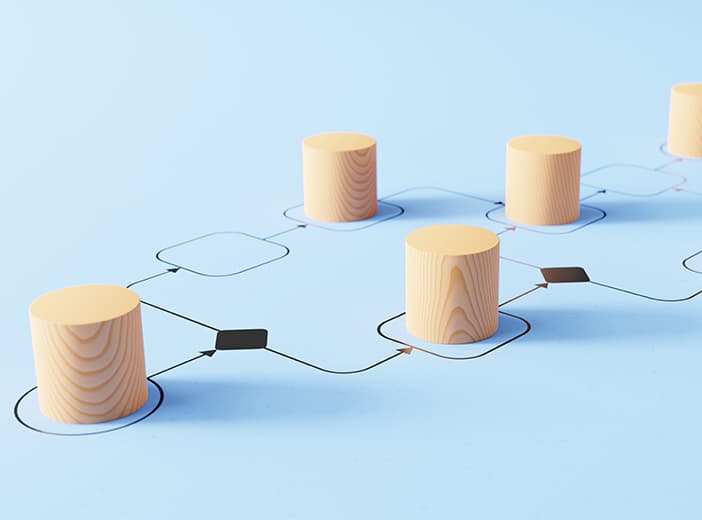Glossary
Data innovation
Data innovation is the use of data and analytics to create new added-value products, solutions, processes, organizational methods and markets.
Companies collect huge volumes of data. Unlocking the value in this data means putting it to use, particularly to create new and innovative products and services.
What is data innovation ?
Data innovation refers to using data and analytics to create value-added products and services. This requires companies to make data available to all stakeholders so that they can reuse and innovate with it. Open, shared data allows the creation of new uses that benefit the organization, stakeholders, customers and citizens. This includes new services based on visualization dashboards or simplified methods of data sharing.
Data innovation requires organizations to see their data as an asset that delivers added value. Companies and administrations should take advantage of their data assets and use them to innovate and add value.
How do you create new innovative services through data?
While all organizations have large volumes of data, not all of them use it effectively beyond its primary use. Essentially too few organizations are creating new services and products from their data.
Data innovation requires organizations to:
Adopt the right tools
To be able to innovate using data, it is essential to adopt solutions that allow everyone within the business to easily work with your data. Relying on complex data analysis tools that can only be used by a handful of skilled experts is not enough, you need to provide everyone in the organization with seamless access to data through a data experience solution that allows you to democratize data thanks to:
- The ability to connect all types of data (business data, anonymized data, Internet of Things data, reference data, etc.)
- The ability to enrich and cross-reference data to provide in-depth analysis
- A data catalog that allows you to easily explore and access data
- Data visualization features to make data easily understandable by non-experts
- The ability to easily share data across all channels and reuse it (via APIs or download)
Collaborate with their partner and customer ecosystems
Collaboration with your industry’s partner and customer ecosystem is essential to enable innovation. This means finding ways to share data without compromising security and while maintaining competitive advantage.
Companies that collaborate in this way can enrich their own data with high value-added information, as well as ensuring they are creating new services that better meet the needs of their customers. This can open new revenue streams and differentiate from competitors. As well as regular meetings and workshops, hackathons also foster data innovation by involving a range of partners and participants in a time-limited scenario..
Data governance and culture
To effectively use data for innovation it has to be high-quality and trusted, otherwise it will not be used. This requires robust data governance processes to ensure the integrity, quality and reliability of information. Effective data governance frameworks allow everyone to fully exploit the potential of data.
Simply providing access to data is not enough to create innovation – employees must be engaged and confident in using and innovating with data. That requires the development of a data-driven culture across the organization, where everyone understands data and wants to use it as part of their working lives.
3 examples of data innovation
Michelin
In the automotive industry, companies are focused on personal safety, improving the driving experience and reducing the environmental impact of car use. Mobility data is the way to achieve these goals.
Tire company Michelin uses different types of data to improve its services. For example, it analyzes data related to braking patterns to help create better performing tires, thus improving the driving experience of motorists and limiting the risk of accidents. Michelin also uses other data, such as around driver behavior to create innovation and improvements to its products.
Schneider Electric
As a leader in the energy sector, Schneider Electric is committed to helping increase sustainability and reduce energy use. Using data is key to creating innovative new services that deliver on these aims.
To industrialize innovation through data, the company has created its own Data Factory program. This shares data across the company and with its customers and partner ecosystems and has led to the development of new value-added solutions internally and externally.
SFR
Telecoms company SFR uses the data generated from its 21 million users to drive innovation and new services. Its analytics team anonymizes and transforms this mobile network data into useful indicators which it sells to organizations in the retail, event, tourism and mobility industries. The aim is to enable these companies to improve their customer knowledge, optimize decision-making or launch new services through the data made available by the platform.
Learn more

Blog
Data virtualization: securely share your data on your marketplace, without duplicating or moving it
Data virtualization transforms the way organizations share and use their data. It allows data from external sources to be explored and consumed securely, without the need for duplication. In this article, Coralie Lohéac, Lead Product Manager at Opendatasoft, explains how deploying data virtualization within a data marketplace opens up new perspectives for data sharing and value creation within organizations.

Blog
Transforming public data into value – lessons from Australia
Cities and municipalities create huge volumes of data - but ensuring it is used effectively by every department to engage stakeholders and build trust can be difficult. Using real-world examples from a new ebook published by our partner Peclet, we explain how municipalities can truly turn data into value.

Blog
Data lineage: the challenges and benefits
Data lineage has become crucial for enterprise data management. With the increasing volumes of data used in decision-making, it's critical to know where it comes from, how it's been transformed, and where it's flowing to. Data lineage brings this transparency, improving data quality, governance, and compliance.
